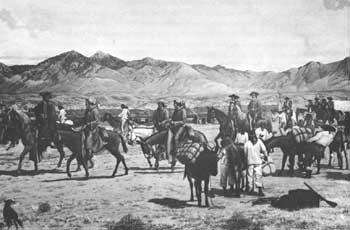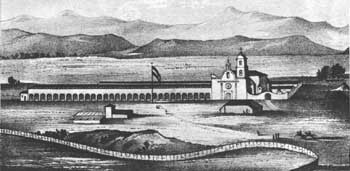






Historical Background
The Spanish Conquistadors and Padres (continued)
CALIFORNIA: THE LAST COLONY
The California coast, endowed with a wonderful climate and peopled by docile Indians, was ideally suited for the pastoral mission system by which New Spain had been slowly extending her northern frontiers. Elsewhere in the present United States the system had either failed or met with only moderate success; in California it thrived and reached perfection. Nevertheless, California was the last area in the United States to be penetrated by Spain—and not until the frontier lay virtually dormant elsewhere. Located as it was so far out on the lifelines of the Spanish Empire in the New World, California was sparsely populated and neglected.
Though the Spanish explored the Pacific coast extensively only a few decades after they began to explore the. Atlantic and gulf coasts, they had but meager information about California. At the same time that Moscoso was leading the weary survivors of the De Soto expedition across east Texas and Coronado was returning dejectedly homeward from New Mexico, in 1542-43, the Juan Rodríguez Cabrillo expedition of two vessels was cruising northward from Navidad along the Pacific coast of California. After discovering San Diego Bay, Cabrillo moved up the coast to the vicinity of Point Reyes, a storm causing him to miss the Golden Gate. He died shortly thereafter, and Bartolomé Ferrelo assumed command. He reached the vicinity of the Oregon coast—perhaps between the 42d and 44th parallels—before returning to his home port. In 1602-3, Sebastián Vizcaíno also sailed up the coast, into Monterey and Drakes Bay, and explored the coastline of Oregon. Despite this exploration, Spain's chief interest in the area that is now the United States was focused for the next century and a half, not on California and the Pacific coast, but on Florida and the gulf coast region.
 |
| Carmel Mission, California, in 1835. From a lithograph by Day & Haghe, published in 1839. (Courtesy, Bancroft Library, University of California.) |
In the mid-18th century, Spain was spurred to colonize California by Russian fur-trade and exploratory intrusions on the Pacific coast, from Alaska as far south as Oregon, and the desire to provide supply and watering facilities for her Manila galleons. Colonization began in 1769 with a combined sea and land approach from Baja California. Under the leadership of Gaspar de Portolá and Father Junípero Serra, a Franciscan missionary, the overland expedition reached San Diego Bay in two stages. The sea party, consisting of two vessels of colonists and a supply ship, was less successful. The supply ship was lost at sea; the other two became separated, lost their bearings, and their passengers fell prey to scurvy before they landed. When finally assembled, the little band of California pioneers consisted of 126 persons. On July 16, Father Serra consecrated San Diego de Alcalá Mission.
Two days earlier an overland expedition commanded by Portolá had headed up the coast toward Monterey Bay, which had been discovered by Vizcaíno. Portolá failed to recognize Monterey Bay, but stumbled by accident onto "a very large and fine harbor such that not only all of the navy of our most Catholic Majesty but those of all Europe could take shelter in it." It was, of course, San Francisco Bay. And Portolá had seen only a part of it. After a brief exploration, the party turned south, identified Monterey Bay, and returned to San Diego.
There the men found a critical situation. Fifty men had died, the natives had become unruly, and the little colony was on the point of starvation. Most wanted to abandon the enterprise and return home, but Father Serra vowed that he would never leave. Just when things looked the blackest, the sails of a supply ship were sighted, and the venture was saved. Quickly Portolá and Serra organized another expedition to Monterey Bay. In June 1770, to secure Spain's hold on the California coast, the Spanish founded the presidio of Monterey and the mission San Carlos de Borroméo.
 |
| Presidio of Monterey, in 1791. During the Spanish and Mexican periods Monterey was the hub of social, military, economic, and political activities in California. From a drawing by José Cardero. (Courtesy, Bancroft Library, University of California.) |
During the next 2 years, as additional Franciscans and colonists arrived in California, Father Serra busied himself with establishing new missions between San Diego and Monterey. In 1771, he relocated the San Carlos mission a few miles away from the presidio at Monterey along the Carmel River, from which it took its permanent name. Traveling down the coast, in July 1771 he founded San Antonio de Padua Mission; and, in September, the mission San Gabriel Arcangel, about 9 miles east of the site of Los Angeles. A year later, he dedicated another mission, San Luis Obispo, between San Antonio and San Gabriel. In 1774, he moved the San Diego mission to a new site 6 miles away from its original location.
 |
| The Spanish explorer Juan Bautista de Anza. In 1774, he founded an overland route from Tubac, Arizona, to San Gabriel Mission, California. Subsequently he explored the San Francisco area and in 1777-78 served as Governor of New Mexico. From a conjectural painting, by an unknown artist, at Tumacacori National Monument, Arizona. |
Two major problems yet faced the California venture: the opening of a land supply route from Spanish bases in Old Mexico and the occupation of the San Francisco Bay region. Many more colonies were needed, as well as livestock for a stable economy. The presidio and missions, remote from Spanish New World bases, were entirely dependent upon the uncertain arrival of supply ships. Father Serra returned to Mexico City, obtained the enthusiastic support of the new Viceroy, and helped plan a remarkable expedition from Sonora that was to culminate in the founding of San Francisco.
Meanwhile, Juan Bautista de Anza, the captain of the presidio at Tubac, had written the Viceroy of his proposed route to California. Appointed to lead the expedition being planned by Father Serra, Anza in 1774 opened the route from Tubac to Los Angeles. He traveled down the Gila to the Colorado, into the deserts and sand dunes of the California border—where his party almost lost its way—up San Felipe Creek into the Sierra Nevada, through San Carlos Pass, and then down into the valley of Los Angeles.
Returning to Tubac after a visit to Monterey Bay, Anza organized a colonizing expedition that departed in November 1775 for San Francisco Bay. With about 225 settlers, he reached Monterey in January 1776. Not Anza but his second in command actually founded a colony at the Golden Gate, in the autumn of 1776. The settlers built a presidio overlooking the harbor, and some distance from the bay, on a stream named Dolores, Father Serra erected a little mission. Anza himself left to become Governor of New Mexico and never returned to California, but his route was used to help colonize and supply the Pacific coast from Sonora. In 1776, Fathers Francisco Atanasio Domínguez and Silvestre Escalante failed in an attempt to develop an overland route from Santa Fe, New Mexico, to California.
 |
| "The Mission of San Francisco, Upper California," probably San Francisco de Solano (Sonoma) Mission, in 1835. From a lithograph by Day & Haghe, published in 1839. (Courtesy, Bancroft Library, University of California.) |
The settlements in California grew and prospered. Monterey became the capital; in 1777, one of Anza's lieutenants established the village of San Jose; in 1781, the Spanish founded the pueblo of Los Angeles; and the following year, Santa Barbara Presidio. The last of the pueblos established was Villa de Branciforte (Santa Cruz), in 1797. The mission system expanded even more rapidly than the civil settlements—despite occasional Indian resistance and the martyrdom of some Franciscans. The padres founded San Juan Capistrano the same year as San Francisco Asís, 1776; Santa Clara, 1777; San Buenaventura, 1782; Santa Barbara, 1786; Purísima Concepción, 1787; Santa Cruz and Soledad, 1791; San José, San Miguel, San Fernando, and San Juan Bautista, 1797; and San Luis Rey, 1798. Three small missions were added to the chain early in the 19th century: Santa Inez, 1804; San Rafael, 1817; and San Francisco Solano, 1823.
In all, the Franciscans founded 21 missions in California—the last one, in 1823, during the Mexican administration—and small settlements grew up around most of them. The economy of Spanish California was agrarian, as in most other Spanish colonies, the missions being its chief element and forced Indian labor its main support. This economy continued for the first 12 years of the Mexican regime. In 1833, however, Mexico began secularizing the missions, despite the strenuous opposition of the padres, who had successfully forestalled similar Spanish decrees. These decrees called for the freedom of the Indians from missionary control, the granting to them of citizenship and lands, and the conversion of the missions into pueblos under civil jurisdiction.
 |
| Juan Bautista de Anza's second expedition to California, in 1775-76. Anza led about 225 colonists from Tubac to Monterey. They later settled at the site of San Francisco. (From a painting, by Cal Peters, at Tumacacori National Monument.) |
The Franciscans, maintaining that the Indians were not ready for freedom and not wishing to give up their temporal powers, vehemently opposed secularization. Friction and hostility with Mexican officials ensued. The Indians poorly comprehended the new measures, designed for their progress, and the missionaries influenced them against the Mexican Government. Destroying livestock and mission property, many of them fled into the wilderness. Vandals raided deserted missions and confiscated property and lands. The Mexican Government, realizing its failure, in 1845 issued a proclamation providing for the rental or sale of the missions. The result of a decade's confusion was, besides the tragic scattering of the neophytes, the destruction of most of the mission buildings.
 |
| Spanish settlements in present United States. (click on image for an enlargement in a new window) |
The fortunate combination of mild climate, fertile soil, and Indian labor provided Spanish settlers in colonial California a life of leisure, ease, and even indolence. Some Spaniards and a larger number of Creoles, who had come from impoverished circumstances in Old Mexico, formed the upper layer of the socioeconomic structure and participated in the bounteous prosperity and life of idyllic graciousness. Thus California remained loyal to Spain during the first years of the independence movement in Mexico, which came to fruition in 1821, and only with some reluctance joined the Mexican Republic. Political unrest and turmoil in the 1830's and early 1840's presaged the official acquisition of California by the United States in 1848, at the end of the Mexican War.
 |
| San Luis Rey de Francia Mission, California, in 1829. From a lithograph by G. & W. Endicott, published in 1846. (Courtesy, Bancroft Library, University of California.) |
 |
 |
http://www.cr.nps.gov/history/online_books/explorers-settlers/intro6.htm
Last Updated: 22-Mar-2005